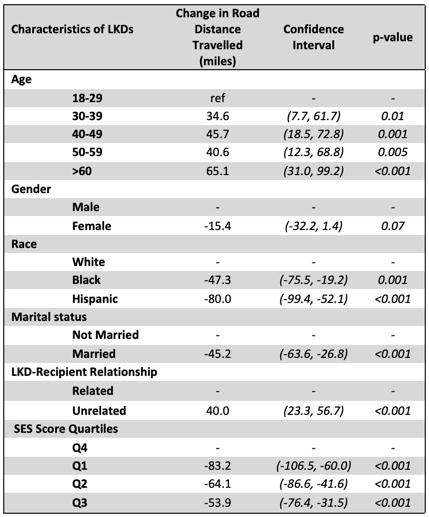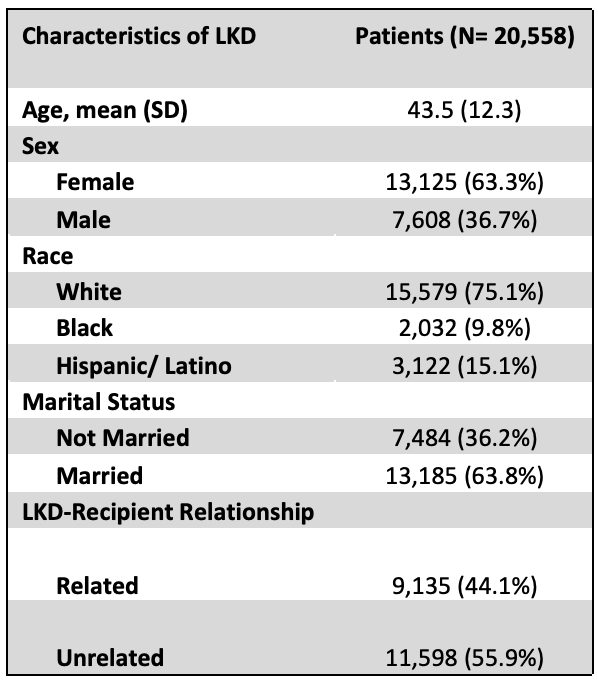Disparities Associated with Road Travel Distance of Living Kidney Donors in the United States: An SRTR Analysis
K. Nijhar1, A. Kernodle1, J. D. Motter1, K. Khoo1, A. Massie2, E. King3, D. Segev1
1Johns Hopkins University, Baltimore, MD, 2Johns Hopkins School of Medicine, Baltimore, MD, 3Johns Hopkins Hospital, Baltimore, MD
Meeting: 2022 American Transplant Congress
Abstract number: 1748
Keywords: Kidney transplantation, Living donor, Living-related liver donors, Multivariate analysis
Topic: Clinical Science » Kidney » 50 - Health Equity and Access
Session Information
Session Time: 7:00pm-8:00pm
 Presentation Time: 7:00pm-8:00pm
Presentation Time: 7:00pm-8:00pm
Location: Hynes Halls C & D
*Purpose: To identify disparities associated with travel distance of living kidney donors (LKDs) in the United States.
*Methods: We identified all U.S. citizen adult LKDs from 2015-2018 using SRTR data with novel linkage to the U.S. Census Bureau’s American Community Survey via LKD census tract codes. Road travel distances between LKD census tract and recipient transplant center were estimated from geographic coordinates using Google Maps application programming interface scripts. Using multivariable linear regression, we explored the relationship between characteristics of LKDs and travel distance. In addition, we computed a standardized socioeconomic status (SES) metric using census-tract level measures that included household income, house value, households with nonwage income, education, and occupation.
*Results: From 2015-2018, we identified 20,733 LKDs (Table 1). The median road travel distance was 58.3 miles (IQR: 21.6 – 234). Compared to LKDs aged 18-29 years, LKDs aged 30-39 years traveled 34.6 miles further to reach the recipient transplant center, with those aged >60 traveling the furthest (65.1 miles). In addition, compared to White LKDs, Black and Hispanic/Latinos LKDs traveled less, with Hispanic/Latinos traveling the least distance at 80.0 miles. Compared to LKDs related to recipients, LKDs unrelated to recipients traveled 40 miles further. Compared to LKDs with SES score greater than 75% percentile, LKDs with SES less than 25% percentile and between 25-50th percentile traveled 83.2 miles and 64.1 miles less, respectively (Table 2).
*Conclusions: Our findings highlight racial and socioeconomic differences in distance traveled by living kidney donors. Distance to transplant center, and difficulty in travel, may constitute a barrier to living donation for potential donors who are Black or Hispanic/Latino, or who have low SES.
To cite this abstract in AMA style:
Nijhar K, Kernodle A, Motter JD, Khoo K, Massie A, King E, Segev D. Disparities Associated with Road Travel Distance of Living Kidney Donors in the United States: An SRTR Analysis [abstract]. Am J Transplant. 2022; 22 (suppl 3). https://atcmeetingabstracts.com/abstract/disparities-associated-with-road-travel-distance-of-living-kidney-donors-in-the-united-states-an-srtr-analysis/. Accessed December 10, 2025.« Back to 2022 American Transplant Congress


